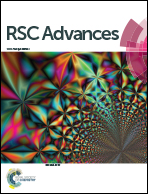Hydrothermal synthesis of nanostructured flower-like Ni(OH)2 particles and their excellent sensing performance towards low concentration HCN gas†
Abstract
Hierarchically structured Ni(OH)2 particles with a well-defined flower-like morphology were synthesized via a hydrothermal route. The molar ratio of SDBS/Ni, hydrothermal temperature and reaction time were found to have a profound influence on the size and morphology of the resulting products. These hierarchically structured flower-like Ni(OH)2 were employed on quartz crystal microbalance resonators for HCN sensing. The flower-like Ni(OH)2 modified QCM resonators exhibited excellent sensing performance. The sensitivity of flower-like Ni(OH)2 modified QCM resonators has reached 5.14 Hz (μg ppm)−1, nearly 40-fold as high as previous reports. The high sensitivity is attributed to its high specific surface area (61 m2 g−1), special morphology and especially to its surface structure. A sensing mechanism that involves surface vacancy sites and their adsorption and activation of oxygen molecules was proposed on the basis of experimental results. Effects of relative humidity show high tolerance of the sensors to relative humidity. The prefect linear relationship between response signal (ΔF) and HCN concentration, and a fast and sensitive response to low concentration HCN coupled with high selectivity show a promising future for these Ni(OH)2 modified QCM resonators in the detection of trace gaseous HCN.


 Please wait while we load your content...
Please wait while we load your content...